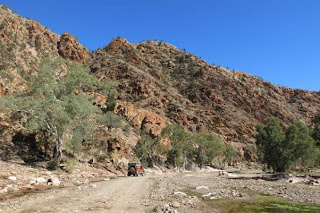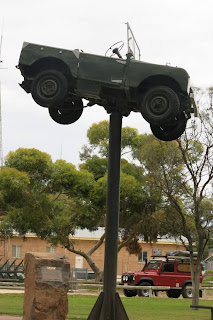Monday, 29 April 2013
On the Road Again
Sunday, 28 April 2013
The Flinders
As we head north, the weather becomes warmer during the day but cools rapidly at sundown so we continue with our central heating – a hot water bottle popped under the duvet an hour before we turn in. Once in the tent it’s cosy and warm, no matter what it’s like outside.
The Australian Arid Lands Botanic Garden is just outside Port Augusta, a small town about a day’s gentle drive north of Adelaide. Kim was keen to see the Sturt’s Desert Pea. It’s an odd looking plant that is the State Emblem of South Australia, although it’s a rarity to find one growing naturally. We found it of course, growing in profusion, but that’s what Botanic Gardens are all about.
Most Australian desert plants are tough, grizzled looking things from a distance, but get close and it’s often a surprise to see delicate little flowers in a wide variety of colours. How about this little gem as an example?
On the road again and we were held up at a rail crossing whilst a train went by, all one and a quarter kilometres of it. There might not be too many trains but they are invariably very long and travel slowly. We waited for quite a while for this one to go by. They stack ‘em high too.
Speaking of trains, we stopped off at Quorn (no not the knitted mushroom vegetarian food but the town). The Pichi Richi Railway runs steam trains on part of the old Ghan railway line built in 1879. Quorn was a major junction. We rode it almost 40 kilometres to Woolshed Flats, nothing more than a halt that was built to take away fleeces that were shorn from the sheep in a shed alongside the railway line. Some challenging engineering enabled the line to be built. The scenery was as spectacular as the steep cuttings, winding narrow gauge track, mountain gorges and many trestle bridges.
Northward again and we entered the Flinders Ranges National Park just north of the town of Hawker. The road climbed upward, tarmac all the way much to our surprise, until we reached Wilpena Pound. So named because the rock formation creates a natural boundary with just a single point of entry. It’s big. We were told that Ayers Rock would fit into it some eight times. At one time 120,000 sheep were farmed there but that number quickly destroyed the vegetation and extremes of weather more or less destroyed the entry point.
Seen from space, it looks like this.
Following the ranger’s recommendation, we walked to the centre of the Pound but decided that it was a bit of a disappointment as all we could see were trees. Still, it was a nice walk. We back tracked and climbed to the top of one of the peaks where we could see into the bowl and where the air was fresh.
Don’t be fooled by the blasé poses. We’d trekked about 10 kilometres during the day and were hot and sticky by the time we made it back to camp, a situation resolved by cold shandies and hot showers.
That night we had a visitor. With no rain in the area for over three months, food is scarce and the local population of kangaroos have taken to scrounging what they can from the campers.
After two days at Wilpena, we moved on. Stopping a few kms out of town where the tarmac runs out, we lowered the pressure in our tyres and set off on dirt, the first real outback road that we’d encountered on this trip. Traffic was almost non-existent, the surface was good; hard, not many ruts or corrugations and only periodic patches of loose stones to negotiate. Mostly we rolled along about 80kph, dropping to 60 on the bends. Vin Rouge, being such a short vehicle, has little directional stability on loose surfaces and care must be taken to avoid sliding on the bends.
Then we encountered the Bunyeroo and Brochina Gorges. Speed dropped to 30k or so, but the scenery was so magnificent, we stopped regularly for a proper look. VR was quite dwarfed by the rocky mountain sides.
A ranger who was passing told us of a rare yellow footed rock wallaby in a small cave and we managed to spot the little chap high up. How he got there we don’t know, but he is a rock wallaby so I guess that explains it.
Lunchtime was approaching as we passed out of the gorge and a stop at Parachilna was called for to check out their ‘feral menu’. Kim had a kangaroo cutlet whilst I enjoyed the kangaroo pie. Then on to Leigh Creek, the last place to top up with fuel and water before hitting the Oodnadatta Track.
Wednesday, 24 April 2013
More Vin Rouge and more Land Rovers
We so enjoyed our visit to Penfolds at Nuriootpa, which I briefly described in our last blog, it seemed appropriate to make a second visit. On Saturday morning (20 April if you’re keeping a check) we arrived at their seat of operations in the town of Magill in South Australia.
In 1844, when he emigrated from Sussex in the UK to Australia, Doctor Christopher Rawson Penfold brought some vine cuttings with him. These he planted and in due course made wine for the medical properties it gave his patients. Sadly he died aged 59; it is rumoured because he did not take sufficient of his own medicine. His wife Mary, an astute woman, developed the wine making business which became successful under her management. Penfolds now claim to be one of the world’s best wine makers.
We joined a tour around the winery, taking in the fermentation vats, cask and bottle cellars; and very informative, interesting and enjoyable it was too. Sampling at the end of the tour was likewise informative, interesting and enjoyable.
Not that we could even contemplate the top of the range wines. If they were for sale, these three bottles would cost in excess of $2,000 – each! Ah well, it doesn’t cost anything to dream and we can still enjoy the so called ‘lesser’ wines. My request to be locked into the cellar was unfortunately turned down.
A fairly quick back-track took us to Adelaide. After setting up camp we took the bus into the city and visited the National Wine Centre. The building is said to resemble a barrel and houses permanent exhibits on viniculture and wines. We weren’t totally impressed and left with the impression that both the building and its contents rather lacked substance.
The Botanical Gardens, however, were a delight. Elegantly laid out with wonderfully inventive displays, we were particularly taken with the rose garden’s specimens from all over the world. The Palm House too we found very elegant with strong Victorian influences carried through to modern times.
There’s not a lot to say about Adelaide. It’s a nice enough city, much like many other cities. We did have a very tasty Vietnamese meal followed by a bit of an adventure getting back to the camp site. The bus driver didn’t speak English and we got off a long way away from our intended destination. Still it was a nice night for a walk.
That night it rained and so next morning we packed up a very wet tent and set forth north in search of better weather. At first we passed through vineyards, hundreds of them, until at last the scenery gradually changed. Fields became much larger and the crop changed to wheat, at least the stubble that remained after the wheat had been harvested. We also passed a lot of grain storage facilities, many with silos and some using vast plastic covered areas that looked like football pitches with low roofs.
Mile after mile went by (OK, kilometre after kilometre if you prefer) with no real change in the scenery. That’s typical Australia of course. Finding a camp site in a small town that rejoices in the name of Crystal Brook, we set up in the rain but fortunately found a brand new camp kitchen in which we prepared our evening meal. Such little luxuries stand out as being special when on the road. That night we were visited by dozens of moths. Nothing too special in that but these were whopping great things, some over three inches long, all trying to get at the light.
Monday morning and a new week. A watery sun peeped through the high cloud as we set off towards the Flinders Range. With quick succession we passed through old railway town of Gladstone, known for having three gauges of railway; Jamestown, the birthplace of R M Williams famed maker of bush clothing, and Orroroo with a huge 500 year old gum tree. All very interesting but . . . .
We stopped at Magnetic Hill, or rather we didn’t stop for long. Magnetic Hill has the peculiar characteristic of making it appear that vehicles roll up hill. We tried it and sure enough Vin Rouge dutifully rolled up hill. We even checked the spirit level mounted on the front wing and that confirmed it –it definitely was up hill. It was all very strange.
The next small town on the route was Wilmington which held no special attraction for us. That is, until we saw a line up of Land Rovers outside the Toy Museum. Well, of course we stopped and before long were in deep conversation with David Christie the owner and his son, the proud owner of a Defender 100. Now I’m not going into the details of this, but suffice it to say that a Range Rover got converted.
David is a Land Rover enthusiast. He has over fifty of them in various states of repair. The earliest dates back to 1949 and there are examples of all models until the present day. Every one of them is, as Kim puts it “a proper Land Rover” (Series 1, 2, 3, Defender and military variations). In addition to the real ones there are half scale and smaller models and the largest collection of toy Land Rovers in Australia. Naturally I was in seventh heaven and we stayed quite a time with David enthusing about his collections and latest renovation projects. I do have to add that it did also prove difficult to get Kim out of the toy museum and she did not hold back during the discussions.
Finally we regretfully said goodbye but not before a few more photographs had been taken.
And so we arrived at Spears Creek, a camp site in the foothills of the Flinders. It was a beautiful spot and we watched the sun go down on a really great day.
Now started a change in our adventures. We’d travelled only a few hundred kilometres north and already there were some significant changes. We’d passed the stone marker identifying the Goyders Line, said to be the limit for safe agricultural development.
We were entering the outback. Some careful thought brought us to Port Augusta, the last sort of major town where we stocked up on food, water, fuel and wine (you can’t be too careful!). Heavily laden with Vin Rouge swaying horribly on the bends, we progressed to the tiny town of Quorn (look it up on the map you lazy whatsit) where I’ll stop writing and enjoy a slightly warmer and dry evening before turning in. And tomorrow? Well, wait and see.
Postscript: ‘Tomorrow’ might be a few days before it gets posted. Mobile phone signals are few and far between in the outback. This has been posted from a town called Hawker (pop 800) and we’re heading north towards Lake Eyre. More posts when we get another signal.



























































